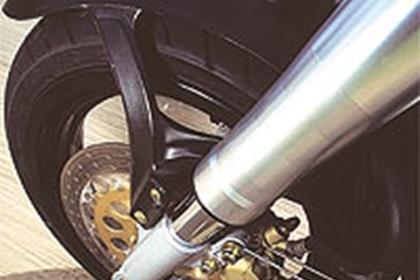The reason behind upside-down forks
TELESCOPIC forks do a difficult job. Not only do they have to keep the front tyre in contact with the road under a wide range of conditions, they also have to withstand braking and steering forces that try to twist and bend them in all directions.
The problems are amplified on the track, where forces are taken to extremes. In the late 1980s, race teams found that by turning their forks upside-down, they improved their bikes’ handling. And upside-down forks are still with us.
In fact, most serious sports bikes have them. But how does turning forks upside-down help and are they really better than conventional ones?
To find the answer, you need to look at the individual parts of a telescopic fork and what you want to achieve.
Forks need to be rigid, to function well as suspension parts and be as light as possible.
Let’s look at suspension operation first as there’s almost no difference between inverted and right-way-up forks in operation.
A fork generally has a spring and damping unit inside. The spring absorbs and releases energy as the fork compresses and extends, and the damper unit controls how quickly it does this. Oil also plays its part in the operation (see separate story, right). Modern set-ups are usually cartridge forks because the damping unit is self-contained. This means the same type of unit can be used regardless of fork orientation. For example, Yamaha’s R6 (inverted forks) and the R1 (conventional forks) have virtually identical cartridges.
The big difference between the two is in their strength. Most of the stress caused by forks bending occurs just below the bottom yoke. When you pull the brake lever you actually brake the wheel – the bike only slows because it’s attached to the forks.
All the momentum of the bike acts through the forks, trying to push the front wheel along.
Chris Taylor, of K-Tech Suspension, explains: ” Inverted forks are much more rigid because they’re held by the larger diameter part of the fork called the slider. Conventional forks mount by the stanchion.
” Most modern bikes with inverted forks use a 53mm diameter slider, but stanchions are rarely over 43mm so it’s easy to see why they’re weaker. Compare inverted and conventional forks and you’ll see the slider is much longer on the inverted forks. ”
The more rigid slider makes up a higher percentage of the overall length. This reduces flex and improves handling and feel.
Inverted forks generally have more overlap – the amount the stanchion protrudes into the slider – than conventional forks. And the more overlap there is, the more rigid the fork – just like an extending ladder.
Inverted forks also have longer slider bushes. These fit between the slider body and stanchion and are what the bearing surfaces act upon. They do the same thing as oil in your engine. By using longer slider bushes, the stanchion is held more firmly and exerts less pressure on them – since they have larger bearing surfaces.
However, longer bushes cause more stiction, another way of saying static friction. So it takes more effort to start the stanchions sliding than it does to keep them sliding. There’s nothing wrong with this, except we want progressive movement so we can accurately control the suspension.
The final advantage of inverted forks is their weight. It’s often assumed inverted forks are heavier because of the carriers, but that’s not the case. The steel stanchion is the heaviest part of the fork assembly and inverted forks have shorter and thinner walled ones. This means less steering inertia and a more responsive feel.


